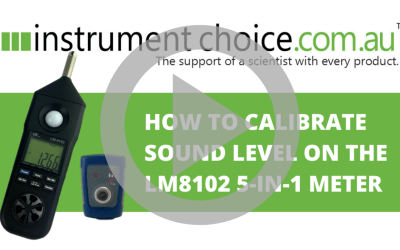How to Calibrate the Sound Level of your LM8102 5-In-1 Multiparameter Meter Yourself

Calibration is vital to keep your scientific instruments in prime working order and to safeguard against inaccurate data.Most sound level meters give you the option to perform an in-house or field calibration of sound level. Instrument Choice scientists recommend you take advantage of this feature between recalibrations when you send your meter to an accredited calibration service.
This video article demonstrates how to calibrate the sound level of an LM8102 sound meter using the CEL-120/1acoustic calibrator for class 1 sound level meters.
Scientist’s Tip: A sound level calibrator is a device that produces sound at a consistent level. If you notice a variance between the output of the calibrator and the sound detected by the meter, you will need to adjust your meter’s settings to match the calibrator output. Our video shows you how to do it.
Figure 1 Watch the Instrument Choice Scientists calibrate sound level on the LM8102 5-in-1 meter here.
How to Calibrate Sound on the LM8102 5-in-1 Multiparameter Meter
You will need:
- An LM8102 5-in-1 sound meter; and
- A sound level calibrator capable of calibrating to 94bB. We are using a CEL-120/1 calibrator.
Here’s the procedure:
- To start, turn on the LM8102. Press the function button until the device is in sound measurement mode.
- Turn on the sound calibrator by pressing the ‘ON’ button. If your device calibrates to multiple sound levels, set it to 94dB.
- Place the calibrator over the sound probe head.
- Enter the sound level calibration mode on the LM8102 by pressing the ‘HOLD’ and ‘MAX/MIN’ button at the same time.
- On this screen, the upper LCD will show the intended sound value, and the lower LCD is the current sound value.
- Wait for the device's measurement to settle, then adjust the expected sound value setting to the value of the calibrator of 94dB. Use the ‘C/F’ buttons to adjust values up and the ‘Function’ button to adjust values down.
- After adjusting, press the ‘MAX/MIN’ button once. Expected and actual units will align.
- Press the ‘UNIT’ button to return to measurement mode. The calibration is now complete.
- Remove the sound calibrator and turn off your meter using the LM8102’s proceed with sound level measurement command.
CONCLUSION
Calibrating your sound level meter at regular intervals ensures you are taking accurate measurements and provides confidence in your sound measurements. The LM8102 is just one of many sound meters available at Instrument Choice that offers user enabled calibration. If you would like to know more about the LM8102 sound meter or any other sound level meters and calibrators, contact us!
ADDITIONAL LINKS
- View the features and specifications of the LM8102 Light, sound, anemometer, relative humidity, and temperature meter
- Take a peek at the acoustic calibrator for class 1 meters
- Watch a video of an Instrument Choice scientist run through the features and functions of the LM8102 here.
Also interesting
Calibration is essential to ensure any pH meter produces accurate and repeatable results. The pH220S, which features automatic buffer recognition, along with an ability to calibrate up to three buffer points, makes the task of calibration effortless.

Salinity meters are easy-to-use tools that indicate water quality, that are a great way to obtain a quick estimate of the dissolved salts present in a wide range of water samples. The IC-Salt2 Salinity Measuring Device is perfect for all kinds of regular salinity testing, including use in educational, agriculture, and aquaculture situations.
Calibration is a crucial task for many types of salt and conductivity meters. The process helps to ensure a device is consistently producing accurate readings.An outstanding feature of the IC-SALT2 Salinity Measuring Device is the ease of calibration, which takes less than five minutes.

